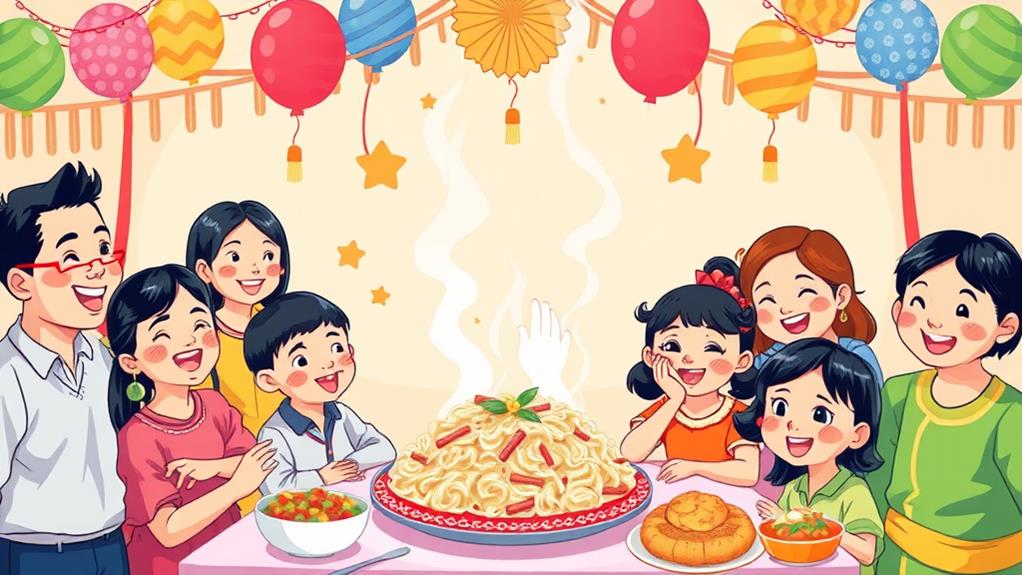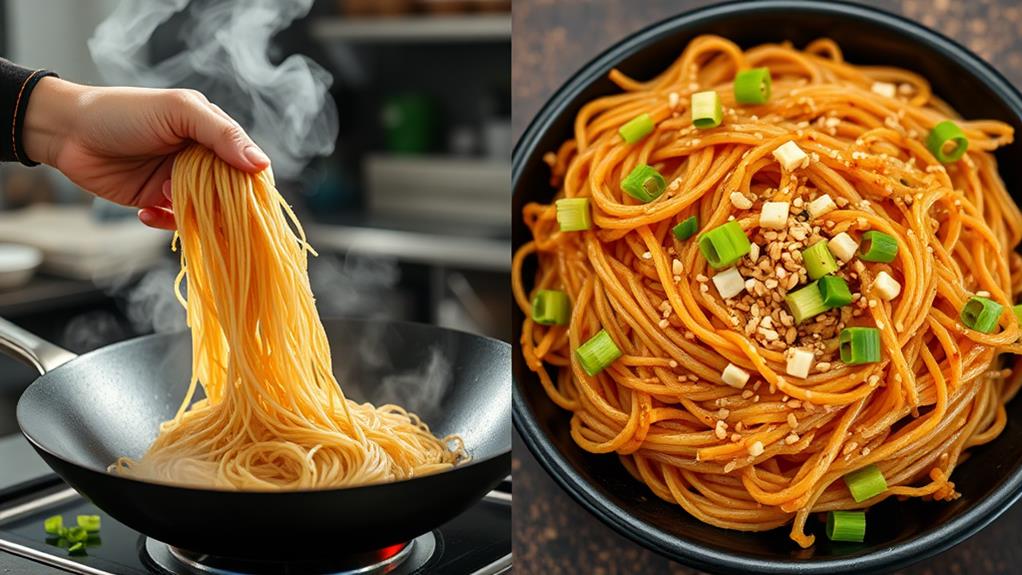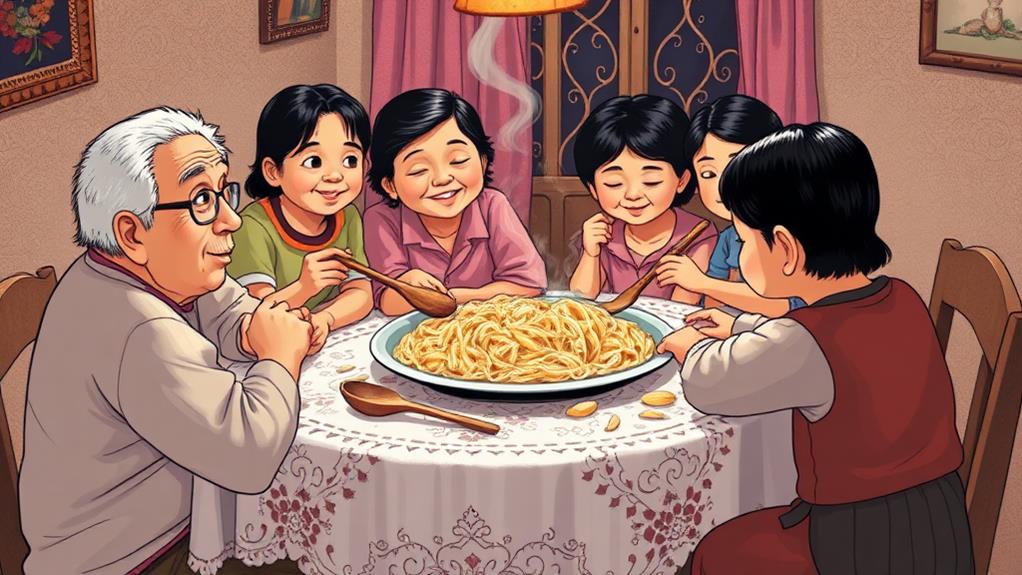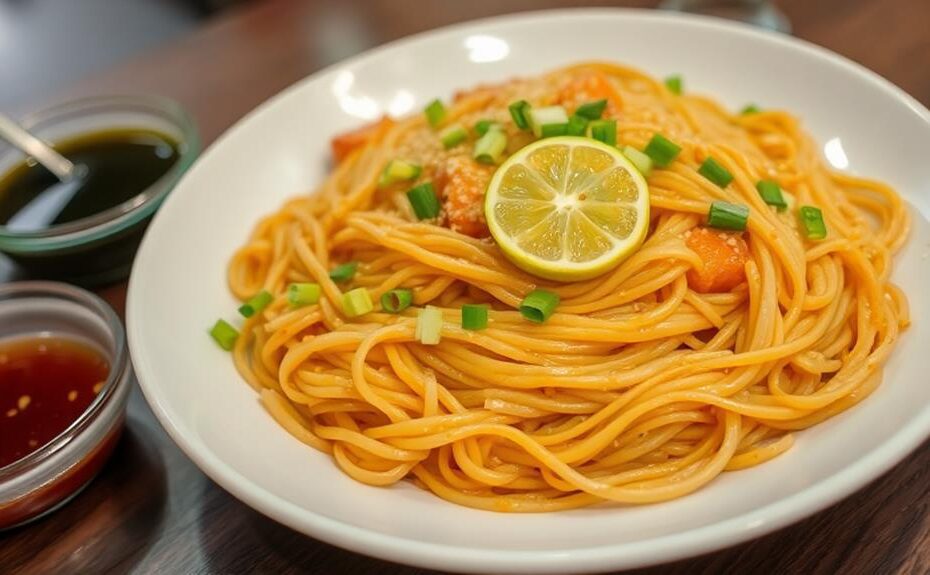Pancit symbolizes long life, prosperity, and community in Filipino culture. This is because it's often served during special occasions and family gatherings, fostering a sense of togetherness and unity.
The dish represents the importance of family ties and hospitality, which are deeply rooted in Filipino values.
Pancit's versatility is another reason it's a Filipino favorite. The ingredients, cooking techniques, and serving styles can vary greatly, making it a staple in both celebrations and daily meals.
For example, some recipes use rice flour noodles, while others use egg noodles or mung bean noodles.
This adaptability has contributed to pancit's widespread popularity across different regions and social classes.
Beyond its cultural significance, pancit also offers nutritional value. It's a good source of carbohydrates, protein, and fiber, making it a balanced and satisfying meal.
Pancit's versatility and nutritional benefits have cemented its place in every Filipino household, making it a beloved dish that's here to stay.
Cultural Significance of Pancit

Pancit is a traditional Filipino dish that symbolizes long life and prosperity. It often takes center stage at birthdays and significant celebrations, highlighting its cultural significance.
The act of preparing and sharing pancit is deeply rooted in Filipino culture, representing hospitality and the importance of family ties.
Sharing a plate of pancit fosters a sense of community and connection among loved ones. It's a staple dish at family gatherings and events, bringing people together and strengthening bonds.
For example, in the Philippines, different regions have their own variations of pancit, such as Pancit Bihon and Pancit Canton, showcasing the country's diverse culinary practices.
As you savor each bite, you're part of a rich cultural tradition that values family, hospitality, and community. This tradition emphasizes the importance of coming together with loved ones and sharing a meal, which is essential to Filipino culture.
Ingredients and Nutritional Value
Pancit Nutrition Facts
A traditional plate of pancit contains approximately 605 calories per serving. This Filipino dish typically consists of rice vermicelli noodles, assorted proteins like chicken, pork, and shrimp, and various vegetables such as cabbage, carrots, and green beans.
Macronutrient Breakdown
Per serving, pancit provides 73.5 grams of carbohydrates, 22.8 grams of protein, and 23.6 grams of fat, making it a satisfying and filling meal option.
Additional Nutritional Value
Pancit is a good source of dietary fiber, with 4.4 grams per serving, and contains a moderate amount of sodium at 494 mg.
Versatility and Customization
Pancit recipes can be easily adjusted to suit individual tastes, allowing for vegetarian options or the inclusion of alternative proteins and vegetables.
This versatility contributes to pancit's enduring popularity as a beloved Filipino dish.
Cooking Techniques and Tips

Mastering Key Techniques for Perfect Pancit
Uniform Cutting for Even Cooking
Cutting vegetables and proteins into uniform sizes is crucial for achieving even cooking and optimal texture in your pancit dish. This ensures that all ingredients cook consistently, resulting in a better-tasting final product.
Preparing Noodles for Flavor Absorption
To prepare rice vermicelli noodles, soak them in warm water until softened. This allows the noodles to absorb flavors better when combined with other ingredients.
When adding the soaked noodles to the stir-fry, don't drain them completely to incorporate the remaining soaking liquid, which adds moisture and flavor.
Creating a Flavorful Base
Stir-fry garlic and onions first to create a flavorful base before adding proteins and vegetables. This enhances the overall taste of the dish.
Achieving Perfectly Cooked Pancit
To cook pancit to perfection, keep the cooking temperature high and stir continuously. This prevents sticking and ensures that all ingredients are cooked evenly.
Serving Suggestions and Variations
Presenting Pancit with Flair
Serving pancit with a side of lumpia adds a complementary flavor profile and texture contrast, elevating this Filipino dish to a stunning centerpiece.
A squeeze of citrus from lime or calamansi wedges adds a refreshing kick that enhances the dish's overall taste.
Experimenting with Variations
Different types of noodles, such as rice vermicelli for Pancit Bihon or egg noodles for Pancit Canton, offer distinct textures and flavors.
Adding sautéed vegetables like bell peppers, snow peas, or mushrooms not only elevates the dish's nutritional value but also adds vibrant colors to the plate.
As a versatile dish, pancit can be adapted to suit various occasions, from simple meals to festive feasts, making it a staple at family gatherings and celebrations.
What Are the Main Ingredients That Make Pancit a Filipino Favorite Dish?
Pancit, a popular Filipino dish, has several key ingredients that make it a favorite among locals and tourists alike. These include rice noodles, vegetables, and various meats such as chicken, pork, or shrimp. These main ingredients can be found in different variations of pancit dish, making it a versatile and delicious meal option.
Personal Stories and Traditions

Pancit: A Dish Steeped in Personal Stories and Traditions
Pancit is more than just a delicious combination of noodles, vegetables, and meat – it's a gateway to a rich tapestry of personal stories and traditions. In Filipino culture, pancit symbolizes long life and prosperity, often taking center stage at family gatherings and celebrations.
Unique Recipes Reflect Personal Traditions
Many families have their own distinct recipes for pancit, passed down through generations. These recipes reflect personal traditions and culinary heritage, showcasing the diversity of Filipino cooking. For example, some families add a special type of noodle or vegetable that's unique to their region or cultural background.
Cooking Pancit Fosters Bonding and Memories
Cooking pancit is a bonding activity that brings family members together. As they share cooking techniques and stories, they create lasting memories. This shared experience strengthens family ties and preserves cultural heritage.
Pancit Unites Communities
Pancit's presence at community events and potlucks showcases its role in fostering connection and shared cultural identity among Filipinos. By sharing a beloved dish, Filipinos come together and celebrate their cultural heritage. This sense of community and shared identity is a key part of Filipino culture.
Pancit Evokes Warmth and Nostalgia
Whether it's a birthday celebration or a casual family gathering, pancit is always there, evoking feelings of warmth and nostalgia. It's a thread that weaves together childhood experiences, family traditions, and cultural identity.
Frequently Asked Questions
Why Is Pancit so Popular?
Pancit's cultural significance contributes to its popularity. Its regional variations cater to diverse tastes, making it a crowd-pleaser.
For instance, family gatherings centered around cooking pancit foster a sense of community, as it brings people together to share in the cooking and eating experience.
The contrasting textures of noodles and vegetables add depth to the dish. This combination of soft noodles and crunchy vegetables provides a satisfying eating experience.
As a celebration food, pancit meets all the necessary criteria: it's nutritious, easy to make in bulk, and has a flavor profile that's both familiar and exciting.
Why Does Pancit Symbolize Long Life?
Pancit symbolizes long life in Filipino culture because of its long noodles, which are associated with longevity. This cultural significance is rooted in traditional beliefs, where the noodles are seen as a symbol of a fulfilling life.
Sharing pancit during family gatherings and festive occasions reinforces the collective hope for a long life among loved ones. For instance, it's common to serve pancit during birthdays and New Year's celebrations, emphasizing the wish for a long and healthy life.
Why Do Filipinos Eat Pancit on Birthdays?
Pancit is a traditional Filipino birthday food because it symbolizes long life and good fortune. This noodle dish holds cultural significance, and its consumption during birthdays is a way to wish the celebrant health and prosperity.
In Filipino culture, pancit is believed to promote long life due to its long, thin noodles, which represent a long and healthy life. This tradition is especially important during birthdays, as it brings families and friends together to share a meal that honors their cultural heritage.
Regional variations of pancit exist, such as pancit lugaw from the northern region and pancit molo from the southern region, showcasing the dish's adaptability and cultural significance. By including pancit in birthday celebrations, Filipinos reinforce community ties and strengthen family bonds, making it an integral part of their traditions.
How Do You Describe Pancit?
Pancit is a culturally rich dish that embodies Filipino heritage. This dish is characterized by its diverse noodle varieties, including rice vermicelli and egg noodles, which provide a mix of textures and flavors.
Quick cooking techniques make pancit convenient to prepare. Additionally, regional differences in pancit result in diverse flavor profiles and presentation styles.
Pancit has a rich history, with origins dating back to the Chinese influence on Filipino cuisine.
It plays a significant role in festive occasions and family traditions, bringing people together with its savory, sweet, and umami flavors.
